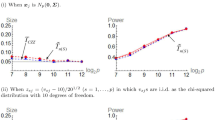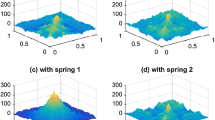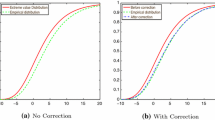Abstract
In this paper, we present a novel method to test equality of covariance matrices of two high-dimensional samples. The methodology applies the idea of functional data analysis into high-dimensional data study. Asymptotic results of the proposed method are established. Some simulation studies are conducted to investigate the finite sample performance of the proposed method. We illustrate our testing procedures on a mitochondrial calcium concentration data for testing equality of covariance matrices.


Similar content being viewed by others
References
Anderson TW (2003) An introduction to multivariate statistical analysis, 3rd edn. Wiley-Interscience, New York
Bai Z, Jiang D, Yao J-F, Zheng S (2009) Corrections to LRT on large-dimensional covariance matrix by RMT. Ann Stat 37:1–34
Benko M, Härdle W, Kneip A et al (2009) Common functional principal components. Ann Stat 37:1–34
Bosq D (2000) Linear processes in function spaces. Springer, Berlin
Büning H (2000) Robustness and power of parametric, nonparametric, robustified and adaptive tests—the multi-sample location problem. Stat Pap 41:381–407
Cai T, Liu W, Xia Y (2013) Two-sample covariance matrix testing and support recoverary in high-dimensional and sparse settings. J Am Stat Assoc 108(501):265–277
Chen K, Chen K, Müller H-G, Wang J-L (2011) Stringing high-dimensional data for functional analysis. J Am Stat Assoc 106(493):275–284
Chen S, Zhang L, Zhong P (2010) Tests for high-dimensional covariance matrices. J Am Stat Assoc 105:810–819
Febrero-Bande M, Oviedo de la Fuente M (2012) Statistical computing in functional data analysis: the R package fda. usc. J Stat Softw 51(4):1–28
Fremdt S, Steinebach JG, Horváth L, Kokoszka P (2013) Testing the equality of covariance operators in functional samples. Scand J Stat 40:138–152
Ferraty F (2011) Recent advances in functional data analysis and related topics. Springer, Berlin
Ferré L, Yao AF (2005) Smoothed functional inverse regression. Stat Sin 15:665–683
Gregory K, Carroll R, Baladandayuthapani V, Lahiri S (2015) A two-sample test for equality of means in high dimension. J Am Stat Assoc 110(510):837–849
Gupta AK, Tang J (1984) Distribution of likelihood ratio statistic for testing equality of covariance matrices of multivariate Gaussian models. Biometrika 71:555–559
Kraus D (2015) Components and completion of partially observed functional data. J R Stat Soc Ser B 77(4):777–801
Li J, Chen S (2012) Two sample tests for high-dimensional covariance matrices. Ann Stat 40(2):908–940
Li W, Qin Y (2014) Hypothesis testing for high-dimensional covariance matrices. J Multivar Anal 128:108–119
Panaretos VM, Kraus D, Maddocks JH (2010) Second-order comparison of Gaussian random functions and the geometry of DNA minicircles. J Am Stat Assoc 105:670–682
Perlman MD (1980) Unbiasedness of the likelihood ratio tests for equality of several covariance matrices and equality of several multivariate normal populations. Ann Stat 8:247–263
Ruiz-Meana M, Garcia-Dorado D, Pina P, Inserte J, Agullo L, Soler-soler J (2003) Cariporide preserves mitochondrial proton gradient and delays ATP depletion in cardiomyocytes during ischemic conditions. Am J Physiol Heart Circ Physiol 285(3):H999–H1006
Schott J (2007) A test for the equality of covariance matrices when the dimension is large relative to the sample sizes. Comput Stat Data Anal 51(12):6535–6542
Srivastava M, Yanagihara H (2010) Testing the equality of serveral covariance matrices with fewer observations than the dimension. J Multivar Anal 101(6):1319–1329
Wang G, Zhou J, Wu W, Chen M (2017) Robust functional sliced inverse regression. Stat Pap 58:227–245
Zhang J-T (2013) Analysis of variance for functional data. CRC Press, Boca Raton
Zhang J-T, Liang X (2014) One-way ANOVA for functional data via globalizing the pointwise F-test. Scand J Stat 41:51–71
Acknowledgements
T. Zhang’s research was supported by National Natural Science Foundation of China (11561006, 11861014) and Natural Science Foundation of Guangxi (2018JJA110013); Z. Wang’s research was supported by National Natural Science Foundation of China (61462008), Scientific Research and Technology Development Project of Liuzhou (2016C050205) and 2015 Innovation Team Project of Guangxi University of Science and Technology (gxkjdx201504).
Author information
Authors and Affiliations
Corresponding author
Additional information
Publisher's Note
Springer Nature remains neutral with regard to jurisdictional claims in published maps and institutional affiliations.
Appendix
Appendix
Denote \({\mathfrak {G}}(t_{1},t_{2},t_{3},t_{4})\equiv {\textsf {E}}\{\varepsilon (t_{1})\varepsilon (t_{2})\varepsilon (t_{3})\varepsilon (t_{4})\}\) and \({\mathfrak {G}}^{*}(t_{1},t_{2},t_{3},t_{4})\equiv {\textsf {E}}\{\varepsilon ^{*}(t_{1}) \varepsilon ^{*}(t_{2})\varepsilon ^{*}(t_{3})\varepsilon ^{*}(t_{4})\}\). To derive the asymptotic properties of the testing method, we make the following assumptions.
-
(a)
For all \(t_{j} \in [0, 1]\), we assume \({\mathfrak {G}}(t_{1},t_{2},t_{3},t_{4})\) and \({\mathfrak {G}}^{*}(t_{1},t_{2},t_{3},t_{4})\) exists.
-
(b)
Assume \(\sup _{t\in [0, 1]}[\mu ^{2}(t)\phi _{l}^{2}(t)]\) and \(\sup _{t\in [0, 1]}[\mu ^{* 2}(t)\phi _{l}^{2}(t)]\) are bounded.
-
(c)
Assume \(\mu (t)=\sum _{l=1}^{\infty }\eta _{l}\phi _{l}\) and \(\mu ^*(t)=\sum _{l=1}^{\infty }\eta _{l}^*\phi _{l}\), where \(\eta _{l}=\int _{0}^{1}\mu (t)\phi _{l}(t)dt\) and \(\eta _{l}^*=\int _{0}^{1}\mu ^*(t)\phi _{l}(t)dt\); \(\gamma (t,s)=\sum _{l=1}^{\infty }\sum _{l^{'}=1}^{\infty } \rho _{ll^{'}}\phi _{l}\phi _{l^{'}}\) and \(\gamma ^{*}(t,s)=\sum _{l=1}^{\infty }\sum _{l^{'}=1}^{\infty } \rho _{ll^{'}}^{*}\phi _{l}\phi _{l^{'}}\), where \(\rho _{ll^{'}}=\int _{0}^{1}\int _{0}^{1} \gamma (t,s)\phi _{l}(t)\phi _{l^{'}}(s)dtds\) and \(\rho _{ll^{'}}^{*}=\int _{0}^{1}\int _{0}^{1} \gamma ^{*}(t,s)\phi _{l}(t)\phi _{l^{'}}(s)dtds\).
-
(d)
\(\min \{n,m\}\rightarrow \infty \), \(\frac{n}{n+m}\rightarrow \alpha \) for a fixed constant \(\alpha \in (0,1)\).
-
(e)
We assume \(n/p^{2}\rightarrow 0\).
-
(f)
All conditions in Chen et al. (2011) are needed.
Assumption (a) is a regular condition in functional data analysis. Assumptions (b), (c) and (e) are used to prove the asymtotic normality of \({\widehat{\rho }}_{ll^{'}}\) and \({\widehat{\rho }}_{ll^{'}}^{*}\). Assumption (d) is a regular condition in two sample test. Assumptions (f) are useful to guarantee high dimensional data which can be converted into a random function.
Lemma 1
Under assumptions 1 and 5, we have
where \(\widehat{c}_{j}=sign({\widehat{\phi }}_{j},\phi _{j})\) and \(\widehat{d}_{jk}=sign({\widehat{\phi }}_{jk},\phi _{jk})\).
The Proof of Lemma 1 can easily be obtained by the Lemma 4.3 of Bosq 2000.
Proof of Theorem 1
Firstly, we prove
It can be observed that
For \(A_{1}\), because of \(X_{i}(t)= \mu (t) + \varepsilon _{i}(t)\) we have
It is easy to see that \(A_{11}\) is the average of independent identically distributed random variables with mean \({\textsf {E}}(A_{11})=0\) and variance \({\textsf {Var}}(A_{11})=\frac{1}{n}\lambda _{l}\). By the central limit theorem, we obtain
where
By Assumptions (c), we have
By (4) and (5) and Assumption (e), we have
For \(A_{2}\), we have
For \(A_{21}\), we have
For \(A_{211}\), by Assumption 4 and Lemma 1, we have
According to Cauchy-Schwartz inequality, we have
Then, we have \(A_{2}=O_{p}(\frac{1}{np})\).
According to Assumption (e), we obtain \({\widehat{\eta }}_{l}- \eta _{l}=O_{p}(n^{-1/2})\). Similarly, we can prove \({\widehat{\eta }}_{l}^{*}- \eta _{l}^{*}=O_{p}(m^{-1/2})\). The proof of (1) is then completed.
Secondly, we prove \(T_{n,m}\xrightarrow {d}\chi _{K^{2}}^{2}\) under \(H_0\). If we can prove that
where
Then together with Slutsky’s Lemma, the first part of Theorem 1 can be proved easily. Therefore, our attention now focuses on proving the first result of (8).
It can be observed that
It is easy to see that \(B_{1}-\rho _{ll^{'}}\) is the average of independent identically distributed random variables with mean 0 and variance \(\frac{1}{n}\lambda _{ll^{'}}\). By the central limit theorem,
Next, we analyze the term \(B_{2}\). In fact, by (1), we have
According to (1), we have
According to Assumption (b) and the results in Kraus (2015), we have \(B_{2}=o_{p}(n^{-1/2})\). Using the arguments similar to that of \(B_2\), we have
Similarity, we can prove
Combing the above discussions, we obtain
Similarly, we can prove \(\sqrt{n}({\widehat{\rho }}_{ll^{'}}^{*}-\rho _{ll^{'}}^{*}) \xrightarrow {d}N(0,\lambda _{ll^{'}}^{*})\). The proof of Theorem 1 is completed. \(\square \)
Proof of Theorem 2
According to the results in the above proof, we have for \(l=1, \ldots , K\) and \(l^{'}=1, \ldots , K\),
Then it yields that
Therefore, under \(H_A\) and Assumption (d), we have
Then Theorem 2 is proved. \(\square \)
Rights and permissions
About this article
Cite this article
Zhang, T., Wang, Z. & Wan, Y. Functional test for high-dimensional covariance matrix, with application to mitochondrial calcium concentration. Stat Papers 62, 1213–1230 (2021). https://doi.org/10.1007/s00362-019-01133-8
Received:
Revised:
Published:
Issue Date:
DOI: https://doi.org/10.1007/s00362-019-01133-8




